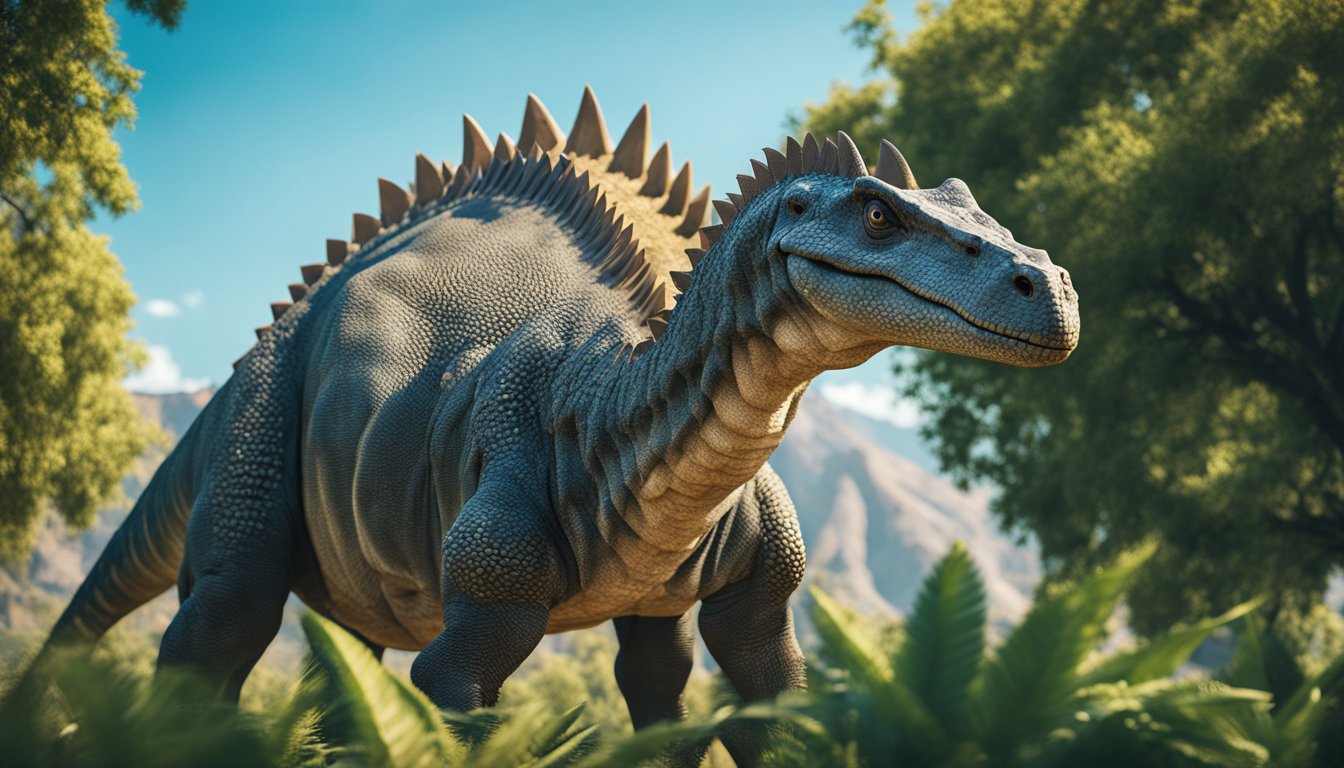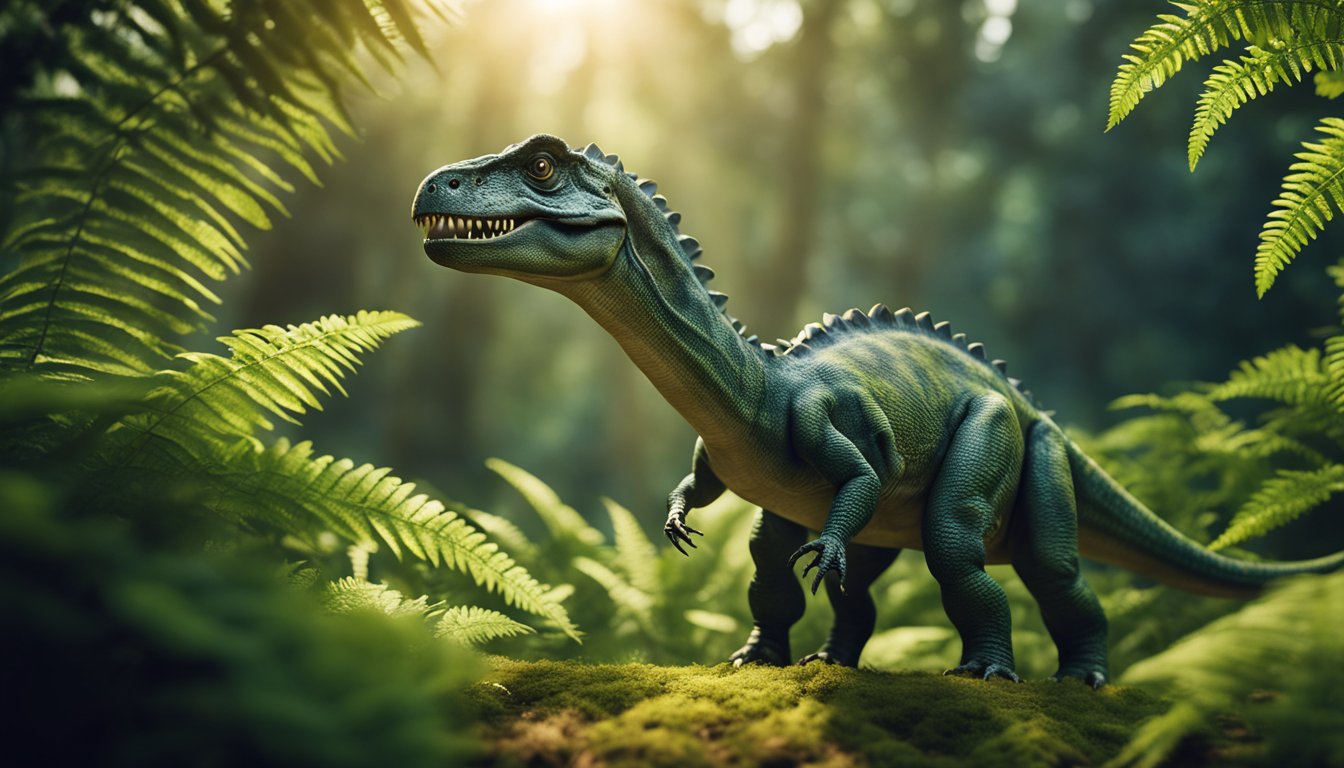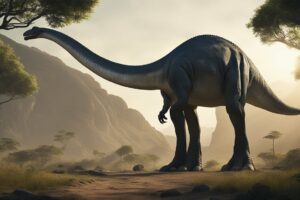Amargasaurus, the dinosaur with a spiky neck, is a fascinating creature that roamed the earth millions of years ago.
This sauropod dinosaur is known for its unique feature of bony spikes that protrude from its neck vertebrae.
These spikes are believed to have been covered by skin, creating a sail-like structure that may have served many purposes, including thermoregulation, display, and defense.

Scientists have discovered that Amargasaurus was a herbivore, with a diet consisting mainly of tough plants.
Its long neck allowed it to reach high treetops, giving it a competitive advantage over other herbivores.
The dinosaur’s neck was also flexible, which allowed it to move its head in different directions while foraging for food.
Amargasaurus was a giant, weighing up to 9000 kg, and it lived during the Early Cretaceous period, around 130 million years ago.
Despite being a fascinating dinosaur, Amargasaurus is not as well-known as some of its more famous relatives, such as Brachiosaurus and Diplodocus.
However, recent discoveries and research have shed new light on this unique creature, making it an exciting subject of study for paleontologists and dinosaur enthusiasts alike.
Unveiling the Amargasaurus
Discovery and Classification
The Amargasaurus is a sauropod dinosaur that lived during the Early Cretaceous period, approximately 132-127 million years ago.
Its fossils were first discovered in Argentina in 1984 by a team of paleontologists led by Dr. Leonardo Salgado.
The fossils were found in the La Amarga Formation, a geological formation that spans across Argentina.
The Amargasaurus belongs to the Dicraeosauridae family, a group of sauropods that are known for their distinctive spines on their neck vertebrae.
The Dicraeosauridae family is closely related to the Diplodocidae family, which includes the famous Diplodocus dinosaur.
Physical Characteristics
The Amargasaurus was a large dinosaur, measuring up to 33 feet in length and weighing over 3 tons.
It had a small head and a long neck, which it used to reach high treetops to forage for vegetation.
Its neck was made up of 14 vertebrae, each of which had a pair of tall spines that protruded from its back.
These spines were up to 60 centimeters long and were likely covered in skin, creating a sail-like structure that may have helped regulate the dinosaur’s body temperature.
The Amargasaurus had a unique skeletal structure that included bony spikes as part of its vertebrae.
These spikes are believed to have served a defensive purpose, protecting the dinosaur from predators.
In addition, the Amargasaurus had teeth that were adapted for grinding and chewing tough plants.
Fun Fact: The Amargasaurus is one of the most complete sauropod dinosaur remains ever found, with rare elements including a partial skull.
In conclusion, the Amargasaurus is a fascinating dinosaur with a spiky neck that has captured the imagination of scientists and dinosaur enthusiasts alike.
Its unique physical characteristics and classification within the Dicraeosauridae family make it a valuable addition to our understanding of the natural world.
A Peek Into the Past

Amargasaurus was a unique dinosaur that lived during the Early Cretaceous period, approximately 129.4-122.46 million years ago.
Its fossils were discovered in the La Amarga Formation in Argentina’s Patagonia region.
The dinosaur’s name “Amargasaurus” means “La Amarga lizard,” named after the formation where it was found.
Habitat and Environment
Amargasaurus lived in a diverse environment that was home to many other dinosaurs, including carnivores and herbivores.
The ecosystem was lush, with a variety of vegetation that provided food for the herbivores.
The La Amarga Formation was a vast area that included forests, rivers, and lakes. The environment was relatively humid, with seasonal rainfall.
Diet and Feeding Habits
As a herbivore, Amargasaurus primarily fed on plants.
Its long neck allowed it to reach high treetops, where it could access untouched foliage, giving it a competitive advantage over other herbivores.
It is believed that the dinosaur’s diet consisted of ferns, cycads, and conifers.
The dinosaur’s teeth were adapted for grinding tough plant material.
Fun Fact: Amargasaurus was not the only dinosaur with a long neck.
Other dinosaurs, such as Brachiosaurus and Diplodocus, also had long necks, but Amargasaurus was unique because of the tall spines on the back of its neck.
Amargasaurus was a fascinating dinosaur that roamed the Earth millions of years ago.
Its discovery has allowed scientists to learn more about the environment and ecosystem during the Early Cretaceous period.
Theories and Hypotheses

Function of the Spines
One of the most intriguing features of Amargasaurus is the long spines on its neck, which have puzzled scientists for years.
Some researchers believe that these spines may have served a defensive function, protecting the dinosaur from predators.
Others suggest that the spines may have been used for sexual selection, with males displaying their impressive necks to attract mates.
Another theory is that the spines may have supported a sail-like structure made of skin, similar to the sails on the backs of some other dinosaurs.
This sail could have been used for thermoregulation, helping the dinosaur to regulate its body temperature by absorbing or reflecting sunlight.
Survival and Defense
Despite the many theories surrounding the function of its spines, one thing is clear: Amargasaurus was a survivor.
This dinosaur lived during the Early Cretaceous period, around 132-127 million years ago, and managed to thrive in a world filled with predators.
Some researchers believe that the spines on Amargasaurus’ neck may have been used to intimidate predators, making the dinosaur look larger and more imposing than it actually was.
Others suggest that the spines may have been used to fend off attackers, with the dinosaur swinging its neck back and forth to strike with its sharp horns.
Whatever the true function of the spines may have been, there is no doubt that they played a crucial role in Amargasaurus’ survival.
This dinosaur was a true survivor, adapting to its environment and evolving unique features to help it thrive in a dangerous world.
In conclusion, while there are many theories and hypotheses surrounding the spiky neck of Amargasaurus, one thing is clear: this dinosaur was a true survivor.
Its unique features helped it to thrive in a world filled with predators, and its legacy continues to fascinate and intrigue scientists and dinosaur enthusiasts alike.
Amargasaurus in the Dinosaur Family Tree

Evolutionary Relations
Amargasaurus belongs to the sauropod dinosaurs, a group of long-necked herbivores that dominated the land for over 140 million years.
Sauropods are part of the larger group of sauropodomorpha, which includes some of the earliest dinosaurs.
They evolved during the Late Triassic period, around 220 million years ago, and diversified into many different forms during the Jurassic and Cretaceous periods.
Amargasaurus is part of the dicraeosauridae family, a group of sauropods that lived during the Early Cretaceous period, around 130 million years ago.
Dicraeosaurids were characterized by their short necks and tall spines that ran down their backs.
This unique feature is what makes Amargasaurus stand out from other sauropods.
Comparison with Other Sauropods
Despite their unique appearance, Amargasaurus shares many characteristics with other sauropods.
Like all sauropods, Amargasaurus was a quadrupedal herbivore with a small head, long neck, and long tail.
Its body was supported by four sturdy legs that could carry its massive weight.
However, Amargasaurus evolved a much shorter neck than other sauropods, which made it more agile and able to move through dense vegetation.
Its tall spines may have served as a form of protection against predators or as a display feature to attract mates.
Amargasaurus is also related to other dicraeosaurids, such as Dicraeosaurus and Brachytrachelopan.
These dinosaurs had similar body shapes and spiny necks, but each species had its unique adaptations to survive in their respective environments.
The fossil record shows that sauropods were incredibly diverse, with over 150 different species known to science.
Some of the largest animals to ever walk the Earth were sauropods, such as the titanosaurs, which could reach lengths of up to 100 feet and weigh over 100 tons.
Overall, Amargasaurus is a fascinating example of the diversity of life that once existed on our planet.
Its unique adaptations and evolutionary history provide us with valuable insights into the ancient world and the many different forms that life can take.
Frequently Asked Questions

How tall was the Amargasaurus and how does it compare to other dinosaurs?
The Amargasaurus was a medium-sized dinosaur, measuring about 33 feet (10 meters) in length and standing about 9 feet (2.7 meters) tall at the shoulder.
Compared to other sauropods, such as the Brachiosaurus and the Diplodocus, the Amargasaurus was relatively small.
What is the significance of the spikes on the neck and back of Amargasaurus?
The spikes on the neck and back of the Amargasaurus were likely used for defense against predators.
These spines were not solid bones, but rather elongated processes of the vertebrae covered in skin.
Scientists believe that the spines may have been covered in keratin, a tough, fibrous protein found in animals such as rhinoceroses, which could have made them even more effective as a deterrent.
When and by whom was the Amargasaurus fossil first discovered?
The first Amargasaurus fossil was discovered in 1984 by a team of paleontologists led by Dr. Leonardo Salgado in the La Amarga Formation of Argentina.
The fossils consisted of a partial skeleton, including a nearly complete neck and back with spines.
What does the name ‘Amargasaurus’ mean and who named it?
The name ‘Amargasaurus’ comes from the La Amarga Formation where the first fossil was found and the Greek word ‘sauros’ meaning ‘lizard’.
The dinosaur was named by Dr. Salgado and his team in 1991.
Can you find Amargasaurus in the ARK survival game, and if so, what’s its role?
Yes, Amargasaurus is a playable dinosaur in the ARK survival game.
In the game, the Amargasaurus is a herbivore with a long neck that can be used to reach high foliage.
It is also able to defend itself with its spiky back.
How fast could an Amargasaurus move, and what does this tell us about its lifestyle?
Scientists estimate that the Amargasaurus could move at a speed of about 15 miles per hour (24 kilometers per hour).
This suggests that the Amargasaurus was a relatively fast-moving dinosaur, which may have helped it to evade predators or cover large distances in search of food.
However, its long neck and heavy body would have made it less agile than some other dinosaurs.





